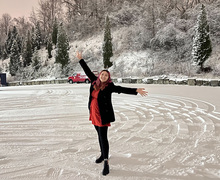Mayor Ben Walsh addressed students’ concerns at sit-in
Molly Gibbs | Senior Staff Photographer
Syracuse Mayor Ben Walsh, pictured here at his "State of the City" address in January, attended the sit-in for about 45 minutes on Saturday afternoon.
Syracuse Mayor Ben Walsh and other city officials stopped by the sit-in at the Barnes Center at The Arch in the wake of several reported racist or bias-related incidents on or near campus.
Walsh, along with Common Council President Helen Hudson and Deputy Mayor Sharon Owens, attended the sit-in shortly after 3 p.m. on Saturday, three days into the peaceful protest. The officials responded to students’ questions and comments about the Syracuse Police Department, correspondence with Syracuse University and the city’s support of the protest. The city officials stayed for about 45 minutes.
Throughout their time in the Barnes Center, Walsh, Hudson and Owens all said multiple times that they supported the protesters and that demanding change can work.
“I hope (this is) a lesson learned that when you do stand up and you make your voice heard, then you can make change,” Walsh said. “And I think that’s what this country is based on that … Just because it’s the status quo or just because it’s always been that way, doesn’t mean it’s the way it should be.”
Walsh said he supported the protesters and wanted to be an ally to them. Students were expressing a lot of consciousness and engagement, he said. The mayor also said he had been in contact with Chancellor Kent Syverud.
BREAKING FROM THE SIT-IN: It was just announced that the Syracuse mayor, Ben Walsh, is coming to the sit-in in two minutes.
— Catherine Leffert (@ccleffert) November 16, 2019
The sit-in comes in the wake of nine hate crimes and bias-related incidents reported on or near campus over against black, Asian and Jewish people since Nov. 7. Protesters said they are frustrated with racism and bias on campus, but also the way the university has reacted — specifically a lack of communication between the administration and the campus community.
#NotAgainSU, the movement leading the sit-in, has a list of 18 demands. The chancellor discussed several of them with students on Friday afternoon, classifying what was feasible and how he planned to respond to them.
“When I spoke with him, I felt in his voice and his heart, and I’ve gotten to know him pretty well, that he is just as troubled as we are,” Walsh said of Syverud.
Walsh encouraged the protesters to make the administration an ally and to work with university officials, including Syverud, to accomplish the demands. When asked if he had looked at them, the mayor said he had seen an early iteration, and thought they all looked “completely reasonable.”
He told press he had been texting with Syverud, along with speaking to him directly, and that their staffs have been interacting.
Walsh told The Daily Orange that he went to the sit-in on Saturday because he was encouraged to by the campus community. He said prior to that, he had wished to respect the relationship between the students and the administration, but added he’d be happy to go back to the sit-in at some point.
Walsh also said he’s been in contact with SPD Chief Kenton Buckner related to a swastika drawn in a snowbank near campus. The swastika is the only incident in the past 10 days within SPD jurisdiction and not under the Department of Public Safety because it’s off campus. Walsh said he told SPD to deploy any resources necessary to investigate the hate crime.
Hudson said she was proud of the protesters for demonstrating, and proud that she was able to go and be there with them.
“We’re fighting it on all fronts, but what do they say? We’re stronger on all fronts. So let’s stick together, let’s stay stronger and let’s fight back,” Hudson said.
Owens, an SU alumna who graduated in 1985, said she was also proud of students for being at the sit-in. She added that the racism felt is not isolated to SU, but that students should continue to demand better.

Walsh, Hudson and Owens said they supported the protesters and that the city is in contact with the university. Catherine Leffert | Managing Editor
“What you’re feeling here on this campus right now I felt when I was here in the 1980s,” Owens said.
Multiple protesters in the crowd said they appreciated the city officials being there, and that it was the most genuine interaction they had experienced with community leaders at the sit-in. One student asked Walsh what the students could learn from the day.
“I hope (this is) a lesson learned that when you do stand up and you make your voice heard, then you can make change,” Walsh said. “And I think that’s what this country is based on that … Just because it’s the status quo or just because it’s always been that way, doesn’t mean it’s the way it should be.”
Published on November 16, 2019 at 8:13 pm Contact Catherine: ccleffer@syr.edu | @ccleffert





